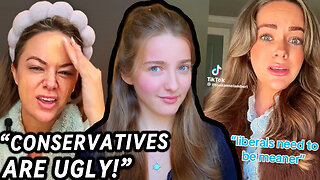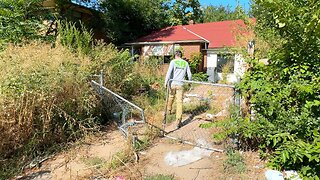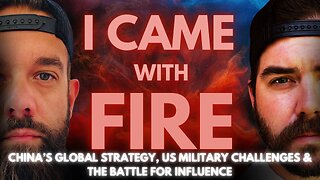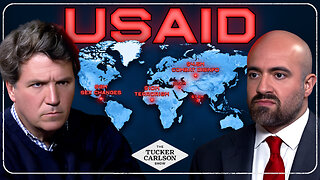Premium Only Content

Russia 1985-1999 TraumaZone | Adam Curtis | Ep 1. 1985 to 1989 (see description for full playlist)
full playlist: Adam Curtis | Russia 1985-1999 TraumaZone | (2022) https://rumble.com/playlists/I12Kd8gTf8A
oher other Adam Curtis playlists:
The Century of the Self | (2002) https://rumble.com/playlists/B71xYg9VcMs
The Power of Nightmares | (2004) https://rumble.com/playlists/AcND0AIdwxw
The Mayfair Set | (1999) https://rumble.com/playlists/TY6kr3k8rZA
Miscellaneous https://rumble.com/playlists/H5NqdFg4G4U
The Trap | (2007) https://rumble.com/playlists/F9hYmAMJPNM
All Watched Over by Machines of Loving Grace | (2011) https://rumble.com/playlists/UEeqeUNA5tM
Can't Get You Out Of My Head | (2021) https://rumble.com/playlists/dfM0eugWsFI
The BBC released Russia 1985–1999: TraumaZone, a seven-hour documentary series by Adam Curtis about the birth of post-Soviet Russia. It is assembled from materials from the Moscow branch of the BBC. Critic Anton Khitrov explains how Curtis answers the main question about Russia that worries people around the world today—and why metaphors play such an important role in his documentary project.
This is not the first time the famous British documentarian Adam Curtis has explored Russia: the crisis of democracy around the world is his most important topic, and using Russian material it can be revealed more than clearly. His penultimate work, “I Can’t Get You Out of My Head,” featured Eduard Limonov, and the series “Hypernormalization” featured an episode about the political technologies of Vladislav Surkov.
The new project “Russia 1985–1999: TraumaZone”, filmed for the BBC channel, where almost the director’s entire career was spent, is entirely about post-Soviet countries, primarily about Russia (from time to time Curtis looks into other states of the former USSR). At the beginning of each episode, after the title, there is a subtitle, “What It’s Like to Survive the Collapse of Communism and Democracy.”
"TraumaZone" is a seven-hour collage of archival footage filmed by the Moscow branch of the BBC over 14 years. For Curtis, the format is familiar - with the caveat that this is his first series without a voiceover. The narrator reveals himself only in the explanatory credits, and not in every scene. The director's main and almost only tool in this work is editing.
The trauma that Curtis puts into the title is not only the trauma of poverty, although a large part of the series is devoted to it (here is a young couple trying to make money from homemade porn, here are workers selling crystal at the station that they were given instead of wages, here is a woman washing clothes in a hole , here are parks cut down for firewood). It is also the trauma of violence.
In Ukraine, a mass grave of those repressed is being exhumed; in Yekaterinburg, the supposed remains of the royal family are being exhumed; everywhere in the former USSR there are traces of recent bloodshed. Violence affects society at all levels: Yegor Gaidar’s economic reforms, which primarily hit the most vulnerable families, in Curtis rhyme with the story of a woman who killed her abusive partner in an attempt to protect herself from him.
Another motif of the series that demonstrates the lack of empathy in a traumatized society is cruelty to animals. Circus workers take the cubs from the tigress. Forest deer are drugged in anticipation of the authorities who will come to hunt. Monkeys languish in cages. The horse, a gift to the British from Turkmenbashi, desperately does not want to go into the container, but they push him there anyway.
Why Russians don’t fight for democracy is a question that is being asked all over the world today. Curtis gives a detailed answer, and does so without arrogant judgment. For starters, he insists, it wasn't always this way. Many viewers will be surprised to see people on the streets of Moscow ready to throw themselves at tanks in 1991 or fight with the police in 1993. The most impressive performance of civil society that the director cites is the movement of soldiers’ mothers during the first Chechen campaign: women tried to take their sons away from the war - and some succeeded (we see one such happy ending in the sixth episode). The fact that there was such a Russia is now rarely remembered. But how was it replaced by the current one?
Curtis consistently shows how Russians become disillusioned with the struggle and any political participation in general. US President Bill Clinton, supposedly the world's main exporter of democratic values, supports Yeltsin in his attack on the elected parliament. In the 1996 election race, the oligarchs include the “spoiler candidate” General Lebed, whose only task is to pull votes away from the communist Zyuganov. Democratic institutions are discredited, people no longer strive to support them, much less defend them. This is how their subjectivity gradually dissolves.
In street interviews, words that are already familiar today are beginning to be heard: the election results are predetermined, voting is pointless. Vladimir Zhirinovsky—Curtis makes him look like an unexpectedly sinister figure, a kind of precursor to Putin—is promising to cancel all elections altogether, hoping that voters will like it.
Russia in the TraumaZone is the territory of fakes. The democracy that they have been trying to build since 1993 resembles a performance addressed to the world. An important image in this sense is Queen Elizabeth II, who, during a visit to Moscow, watches either a ballet or a school production of Hamlet, while shells explode in Chechnya. At the beginning of the series, the factory buys scrap metal in order to sell it according to a “rational” plan. Three episodes later, the Mary Kay cosmetics corporation announces that the American dream has come to Russia and conducts training on selling smiles among local employees. Both are essentially theater. Wealthy Russians have their own show: they play pre-revolutionary aristocracy, holding either balls or receptions with waiters in disguise.
TraumaZone is by no means a historical manual. It's not a matter of mistakes, although the director makes them: he confuses socialism with communism , and for one of the episodes he borrows a fragment from the British feature film "Zinky Boys Go Underground", apparently mistaking the actors for real veterans of the Afghan War. The point is in his method itself.
A comprehensive and impartial account of the birth of post-Soviet Russia is a task for scholars, and Curtis does not pretend to be one. He combines documentary materials, like an anonymous blackmailer - letters cut out from a newspaper, in order to use them to convey his own interpretation of events.
The series regularly features stories with no obvious political or social meaning, but with undeniable artistic power. For example, in the fourth episode, the “Princess of Ukok” appears - the mummy of a young woman recovered from permafrost in the Altai mountains. The discovery is, of course, important, but not so important as to judge Russia in 1993 by it.
Nevertheless, for some reason the director keeps our attention on the blackened body from which measured drops of melt water are falling. He shows these shots long enough to provoke the viewer's imagination. The Altai “princess” spent an eternity in icy captivity, the world to which she returns is no longer unfamiliar to her, and she is absolutely helpless in front of it. Isn’t this a collective portrait of a Russian thrown into a new economic reality?
For a similar purpose, Curtis uses an excerpt from a low-budget Soviet film adaptation of The Lord of the Rings, published on YouTube in 2021: Smeagol, the future Gollum, kills Deagol's friend in order to take possession of the One Ring. It's unlikely that the director is concerned with the specific aesthetics of Soviet television - rather, this episode predicts the fate of Yeltsin, who in the series rapidly goes from democratic leader to corrupt, power-obsessed politician.
Curtis searches in archival records not only for significant evidence of time, but also for secret signs and metaphors that, in a mysterious way, should make his interpretation more convincing. Rhymed text works the same way with our consciousness: if the words are consonant, it seems to us that the phenomena themselves are connected. The director seems to be hoping to discover some intelligent design behind reality - in fact, of course, his own.
Curtis needs all this so that viewers see in his series an artificial construction, which, undoubtedly, reflects reality, but not entirely and not always accurately. This honest self-criticism - like, I don't know this for sure, but it seems to me - helps the director rise above the story he's telling. All political forces operating in the TraumaZone - democrats, communists, nationalists, oligarchs - created virtual reality for supporters and presented it as real. That's the last thing Curtis wants to do. Hence his demonstrative subjectivity.
Anton Khitrov
-
 1:21:15
1:21:15
Tactical Advisor
3 hours agoThe Vault Room Podcast 008 | PSA Changing the Firearms Game and Trump Exposing Government Spending
50.5K18 -
 3:09:57
3:09:57
LittleDude games
7 hours agoSaturday Fortnite Hunters // LittleDude
45.3K8 -
 14:34
14:34
Misha Petrov
18 hours agoTikTok’s WOKE “Mean Girl” Is Insufferable
61.7K70 -
 10:46
10:46
Mike Rowe
1 day agoRiley Gaines Was Right All Along | The Way I Heard It with Mike Rowe
86.7K84 -
 25:19
25:19
SB Mowing
1 day agoI had to do a DOUBLE TAKE because I couldn’t see the house at first
53.6K24 -
 2:15:43
2:15:43
I_Came_With_Fire_Podcast
13 hours agoChina's Global Strategy, US Military Challenges, & The Battle for Influence
54.6K9 -
 2:37:42
2:37:42
FreshandFit
17 hours agoGreg Doucette Guessed Their Body Fat Percentages And THIS Happened...
168K118 -
 5:08:30
5:08:30
Akademiks
17 hours agoKendrick Lamar SPEAKS for first time SINCE BEEF in new Interview. Drake preppin new album. YE WYLING
198K28 -
 2:12:17
2:12:17
Tucker Carlson
18 hours agoMike Benz Takes Us Down the USAID Rabbit Hole (It’s Worse Than You Think)
348K1.21K -
 1:47:17
1:47:17
Roseanne Barr
22 hours ago $46.33 earnedThe Most Offensive Comic, Leonarda Jonie | The Roseanne Barr Podcast #86
206K243